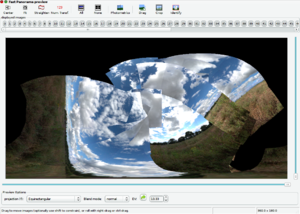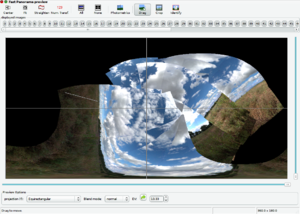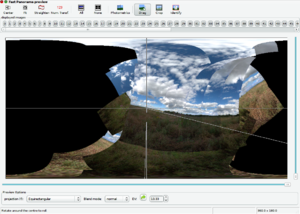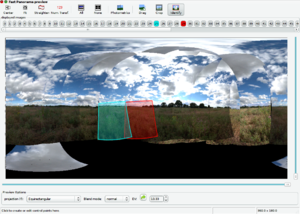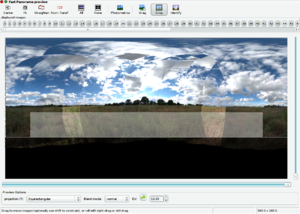Difference between revisions of "Hugin Fast Preview window"
(Minor fixes) |
(Transfer descriptions for missing items) |
||
| Line 103: | Line 103: | ||
The autocrop button adjusts the crop rectangle so that it is entirely within the image area, i.e. there will be no 'black' borders in the final stitched image. It does this by maximising the area of the rectangle rather than the width or height. | The autocrop button adjusts the crop rectangle so that it is entirely within the image area, i.e. there will be no 'black' borders in the final stitched image. It does this by maximising the area of the rectangle rather than the width or height. | ||
| + | |||
| + | == Displayed images == | ||
| + | |||
| + | Every input image in the preview has ''toggle'' button where display can be disabled or enabled. | ||
| + | |||
| + | In addition, this display also controls the behaviour of the [[hugin Optimizer tab]] and the [[hugin Stitcher tab]] - Any photos disabled here are not used in optimisation or stitching. | ||
| + | |||
| + | === [[Image:Hugin_preview_show_all.png]] All === | ||
| + | |||
| + | By default all input images are shown in the preview, however individual images can be enabled and disabled in the | ||
| + | '''Displayed images''' section. Use the '''All''' button to return to the default and display all the images. | ||
| + | |||
| + | === [[Image:Hugin_preview_show_none.png]] None === | ||
| + | |||
| + | Similarly, hide all images with the '''None''' button, use this if you want to enable preview images one by one. | ||
| + | |||
| + | == Preview canvas == | ||
| + | |||
| + | The image window itself shows a representation of the final stitched output panorama, use the scroll bars | ||
| + | to change the horizontal and vertical [[Field of View]]. | ||
==In practice== | ==In practice== | ||
Revision as of 01:01, 2 February 2010
Like the more accurate Hugin Preview window, the fast preview shows something similar to the final stitched output, but with a few important differences:
- Reduced resolution input images are used, so some areas can appear blurred that will be sharp in the final output.
- Seams are not created, images are simply overlaid with the first image at the bottom of the stack and the last at the top.
- Blending by a tool such as enblend isn't shown.
- The brightness display of HDR and 16bit images is controlled by settings in the hugin Preferences, these settings are not used when stitching. The colouring of these images will also be inaccurate when using exposure or white balance correction. For HDR panoramas, the Hugin Preview window is recommended instead.
- Photometric correction only includes white balance and exposure, unless full photometric correction is enabled with the the Photometrics button.
- The remappings are approximate, the output by a tool such as nona is more accurate. If this concerns you more than speed, use the Hugin Preview window instead.
- It's much faster ;-)
The window features a row of tabs at the top, clicking on a tab switches between modes that allow you to interact with the panorama in different ways:
Preview tab
Error creating thumbnail: /bin/bash: line 1: rsvg-convert: command not found Identify
Using this tool you can find where your images are, and match them to their number. You can also edit control points.
When this tool is turned on, move the mouse over the visibility buttons for the images (the numbers at the top of the preview). The image with the number on the button under the mouse lights up red in the preview. Moving the mouse over the panorama highlights all the images under the mouse in different colours. The buttons for those images lights up in matching colours.
When the mouse is on the overlap of two images, click to edit the control points between those images.
Error creating thumbnail: /bin/bash: line 1: rsvg-convert: command not found Photometrics
Enables full photometric correction. When turned on, this will cause significant delay when changing photometric parameters. It also takes a while to turn on and off. However, with it enabled you get much better representation of the colours in the output. With it turned off, you get correction only for exposure and white balance. With it turned on, you also get vignetting and colour response correction. The Hugin Preview window does all these things by default, so you may wish to use that instead.
Error creating thumbnail: /bin/bash: line 1: rsvg-convert: command not found Show control points
When this tool is turned on, all Control points are drawn as lines; red indicates 'normal' control points and blue indicates horizontal control points, vertical control points or straight line control points.
Long red lines indicate a bad alignment or unoptimized images, short red lines or 'dots' indicate a good alignment between control points. Horizontal and vertical control points should be perpendicular in the panorama.
Blend mode
The normal blend mode will draw the images as a stack. The difference blend mode will do the same, except the image under the mouse pointer will be subtracted from the rest of the stack. Use this to determine if the alignment went well: where you can see edges in the subtracted image, these edges are misaligned. Be warned that this isn't fully accurate, the other preview has a better difference mode.
EV
EV stands for Exposure Value, clicking the Reset button will set it to the average of all the input image exposures or setting it to 0 (zero) will result in no exposure change being applied to the panorama.
EV is a standard photographic scale, each increase or decrease by one unit will change the exposure by the equivalent of one f-stop (ie. halving or doubling the exposure). It is worth adjusting the exposure here in hugin rather than later in an external image editor, since hugin uses the camera response curve calculated in the hugin Exposure tab to perform the correction in a linear colour space.
The average value isn't always wanted. If you see colour artefacts in bright sky areas, set this to the negative of the darkest input image - This has a side-effect of clipping brighter images.
Projection tab
This tab is for adjusting projection of the panorama, some projections have adjustable parameters which will appear when selected.
 Fit
Fit
This doesn't change any input image parameters, it just readjusts the output Field of View such that all the input images are visible. If the images are all off-centre, then there will be a lot of black space.
Field of View
This is the horizontal and vertical angle of view of the output image.
Projection
Use the drop down list to change the output projection of the panorama, the list is exactly the same as that in the hugin Stitcher tab. Note that for some projections, the scroll-bar sliders to change the Field of View are disabled. If you are having trouble, switch to Equirectangular Projection, adjust the field of view and switch back.
Error creating thumbnail: /bin/bash: line 1: rsvg-convert: command not found Move/Drag tab
Using this tool you can recentre the panorama interactively. With it turned on, try the following:
- Drag the panorama with the left mouse button to rotate the panorama's images. The centre of rotation is the point where you pushed the mouse button down.
- Hold shift when doing the above to constrain movement to yaw or pitch. Note pitch is affected by the centre of rotation.
- Drag the panorama with the right mouse button or hold control and drag with the left to roll the panorama (rotate around the middle)
If the panorama contains unconnected components, they will move individually.
 Center
Center
This button horizontally pans the output, changing the yaw of the remapped images so they fit to the centre of the output frame. This is useful if there is a lot of black space on the left or right of the output. This also performs a Fit, equivalent to the next button.
Note that centering a Rectilinear Projection or Fisheye Projection panorama will change the perspective, this may be unwanted.
 Fit
Fit
This doesn't change any input image parameters, it just readjusts the output Field of View such that all the input images are visible. If the images are all off-centre, then there will be a lot of black space.
 Straighten
Straighten
Straightening the panorama optimises the roll and pitch of the input images without changing their relative positions, levelling the panorama in the process. This normally produces good results, if you need more accurate positioning, try adding vertical control points in the hugin Control Points tab and reoptimise.
Numeric Transform
Enter a numerical transform to rotate the input images without changing their relative positions - Effectively this rotates the entire panorama. Enter roll, pitch and yaw values in degrees.
Error creating thumbnail: /bin/bash: line 1: rsvg-convert: command not found Crop tab
Using this tool you can set the output cropping region interactively. To do this precisely instead, use the Stitcher tab. Initially, the entire panorama is in the output region (i.e. nothing is cropped).
To change the cropping at each edge, move the mouse towards that edge until a white box appears along it, then drag with the left mouse button until the edge is where you want it. The darker areas represent the region that is cropped off. You can move two edges at once by moving the mouse towards the corner shared by the edges until both white boxes appear. If you wish to move the whole region at once, move the mouse into the middle so that all four edges have boxes along them and drag.
Autocrop
The autocrop button adjusts the crop rectangle so that it is entirely within the image area, i.e. there will be no 'black' borders in the final stitched image. It does this by maximising the area of the rectangle rather than the width or height.
Displayed images
Every input image in the preview has toggle button where display can be disabled or enabled.
In addition, this display also controls the behaviour of the hugin Optimizer tab and the hugin Stitcher tab - Any photos disabled here are not used in optimisation or stitching.
 All
All
By default all input images are shown in the preview, however individual images can be enabled and disabled in the Displayed images section. Use the All button to return to the default and display all the images.
 None
None
Similarly, hide all images with the None button, use this if you want to enable preview images one by one.
Preview canvas
The image window itself shows a representation of the final stitched output panorama, use the scroll bars to change the horizontal and vertical Field of View.
In practice
Let's try using this preview to help with a panorama where automatic alignment failed. This panorama was taken where a lot of things were blowing around in the wind, and the clouds were changing quickly, so it is not surprising that it aligning it is a struggle. The Assistant tab tells us there are multiple unconnected image groups. We can optimise the panorama and end up with a images correctly positioned amongst the group they are in, but the groups themselves are not aligned. Try this first.
Using the Drag tool, we can roughly align the groups together:
- Turn on the tool with the Drag button.
- Drag each component so the horizon is in the middle, using the left mouse button.
- Drag with the right mouse button (or hold control and drag with the left) to level the horizon.
- Hold shift and drag with the left mouse button sideways to approximately line up the image with the other groups.
When we have the images in approximately the right position, we can begin placing control points to guide the optimiser. The Identify tool lends a hand here. Firstly, turn on the identify tool. Move the mouse on an overlap that was recently created between two image groups. The images in the overlap light up. Move the mouse to a place where there is only two images in that overlap, and click. The two images are opened in the control point editor (there may be a short pause while the images are loaded). Once you have placed control points manually, you can return to the preview to find some more image pairs.
When you are happy that your panorama contains sufficient control points, optimise it again. The panorama will likely have the horizon at the wrong angle, in this case press Straighten on the preview window. You can then frame the panorama using the drag tool (hold shift so you don't make it wonky again!). Use your artistic judgement here. If you want to crop your panorama, click Crop and drag the edges of the cropping rectangle.
